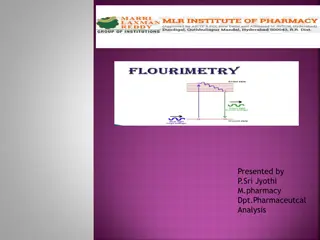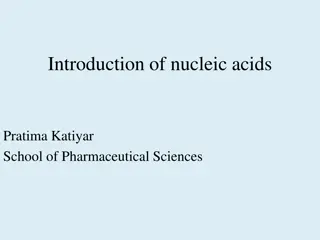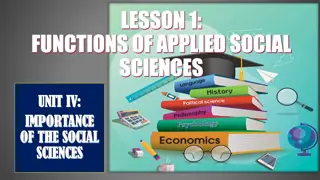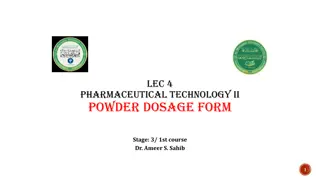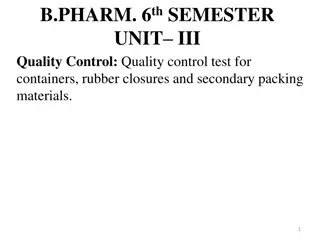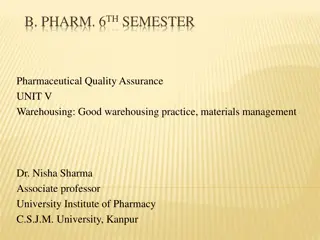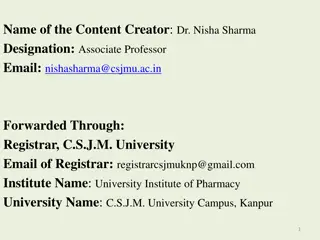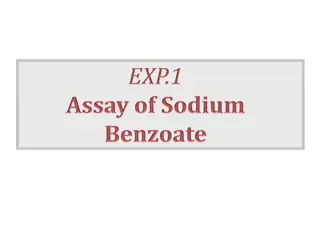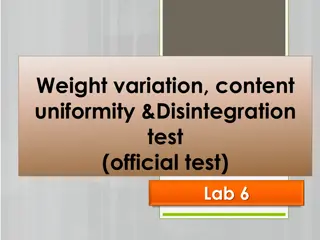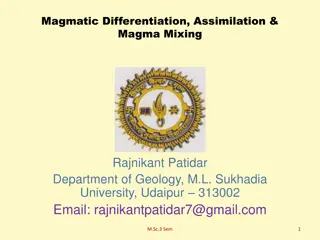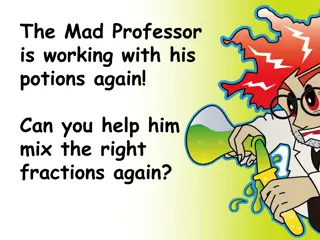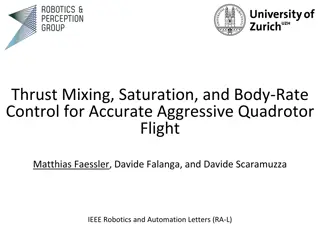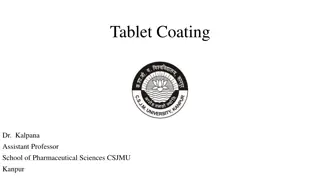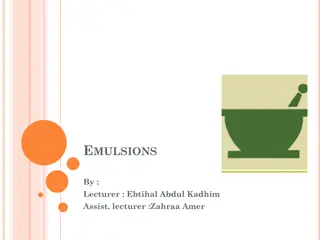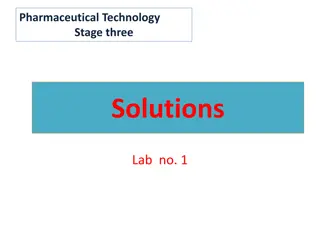Understanding Mixing Processes in Pharmaceutical Sciences
Mixing is a fundamental operation in pharmaceutical sciences, involving blending different substances to achieve uniformity. This process is crucial for various applications, such as chemical reactions, suspensions, and emulsions. The types of mixtures, factors affecting mixing efficiency, and differences between solid and liquid mixing are discussed in detail.
- Mixing Processes
- Pharmaceutical Sciences
- Types of Mixtures
- Factors Affecting Efficiency
- Solid vs Liquid Mixing
Download Presentation

Please find below an Image/Link to download the presentation.
The content on the website is provided AS IS for your information and personal use only. It may not be sold, licensed, or shared on other websites without obtaining consent from the author. Download presentation by click this link. If you encounter any issues during the download, it is possible that the publisher has removed the file from their server.
E N D
Presentation Transcript
MIXING By Mrs. Swarnakshi Upadhyay Assistant Professor School of Pharmaceutical Sciences
Introduction Mixing is the most widely used operation in which two or more than two substances mixed together. Perfect mixing is that in which each particle of one material lies as nearly adjacent as possible to a particle of the other material.
Objective of Mixing Simple physical mixing of material to form a uniform mixture. To promote the chemical reaction to get uniform product. Dispersion of solid in liquid to form uniform suspension and paste. Dispersion of immiscible liquids to form uniform emulsion.
Types of Mixtures Positive Mixtures: when two or more than two miscible liquids are mixed or soluble solid dissolved in liquid, mixtures are called positive mixtures. These mixtures do not present any problem in mixing. Mixture formed is irreversible. Negative Mixing: When two immiscible liquids are mixed or insoluble solids are mixed in liquids, mixtures are called negative mixtures. For preparing such types of mixtures high degree of mixing of material is required. Mixture formed is reversible. Neutral Mixing: These mixtures are static in their behaviour. The substance do not have the tendency to mix with each other immediately, but when mixed they do not separate after mixing.
Factors Affecting Mixing Nature of product: For effective mixing particle surface should be smooth. Particle size: It is easier to mix powder of same particle size. Increasing the difference in particle size will lead to segregation. Particle shape: Particle should be spherical in shape to get a uniform mixture. Particle charge: some particle due to electrostatic charge exerts attractive force which leads to separation. Proportion of material: It is easier to mix powders if available in same quantities. Relative density: If the components have a different density, the denser material will sink through lighter material. Viscosity: An increase in viscosity reduces the extent of mixing.
Cont. Surface tension of liquids: High surface tension reduces the extension of mixing. Temperature: Temperature also affects the mixing because viscosity changes with increase in temperature. Mixture volume: Mixing efficiency depends on mixture volume. Agitator type: The shape, size, location and type of agitator also affect affects the degree of mixing. Speed/rpm of the impeller: Mixing at less rpm is more homogenous than at higher rpm. Mixing time: Mixing time is also very important for appropriate mixing.
Difference Between Solid and Liquid Mixing SOLID MIXING LIQUID MIXING This is achieved by mixing elements of suitable shape to act as impeller to produce appropriate flow pattern in mixing vessel. This is used in preparation of emulsion, suspension and mixtures. In solid mixing two or more substances are intermingled by continuous movement of particles. This is used for mixing of dry powders. Large sample size is required. Small sample size is sufficient. High power required for mixing. Less power required for mixing.
MECHANISM OF MIXING 1. Mechanism of Solid Mixing: Mechanism in involved in solid mixing are Convective mixing, In which group of particles move from one position to another. It also referred to as macromixing. Shear mixing, In this, shearing force is created within the mass of material by the use of a stirring arm or a burst of air. Diffusive mixing, During this mixing, gravitational forces cause the upper layers of material to slip and random motion of individual particles take place on newly developed surfaces. Also known as micro mixing
Cont. 2. Mechanism of Liquid Mixing: Mechanism of liquid mixing are Bulk transport: It is the movement of large portion of material from one location to another location. The movement is done by rotating blades or paddles. Turbulent mixing: In this mixing is due to turbulence. Turbulence is a function of velocity gradient between two adjacent layers of a liquid. Laminar mixing/Streamline mixing: When two dissimilar liquid are mixed through a laminar flow, the shear that is generated stretches the interface between them. In this mechanism layers folds on themselves. As a result, the number of layers, and therefore interfacial area between them, increases exponentially with time. Molecular diffusion: The mechanism responsible for mixing at molecular level is the diffusion resulting from thermal movement of molecules. Primary mechanism responsible for mixing at the molecular level is the thermal motion of molecules. Governed by Fick's fist law of diffusion, dm/dt = - DA dc/dx Where, dm/dt rate of transport of mass across a surface area D Diffusion Co-efficient A Area across which diffusion is occurring dc/dx Concentration gradient
Cont. Mechanisms of Semi-Solid Mixing: The mechanisms involved in mixing semi solids depend on the character of the material which may show considerable variation. Many semi solids form neutral mixtures having no tendency to segregate although sedimentation may occur.
Double Cone Blender Principle: The mixing of powder in double cone blender is due to tumbling and shearing action with blade. Construction: It is made up of stainless steel and is available in different capacity ranging from 5kg to 200kg or even more. The efficiency of blender depends on the speed of rotation. The rate of rotation should be optimium which depends on the size and shape of the tumbler as well as the nature of material to be mixed
Working: The material to be mixed is loaded approximately 50-60% of the total capacity of the blender. As the blender rotates the material undergo the tumbling motion and mixes the material thoroughly. Agitator blades are used to provide shearing action. Advantages: If fragile granules are to be blended, double cone blender is suitable because of minimum attrition. They handle large capacities. Easy to clean, load, and unload. This equipment requires minimum maintenance.
Disadvantages: Double cone blender needs high head space for installation. It is not suitable for fine particulate system or ingredients of large difference in particle size distribution, because not enough shear is applied. If powders are free flowing, serial dilution is required for the addition of low dose active ingredients. Uses: It is used to produce homogeneous solid-solid mixture. It is used for effective mixing of powder and granules. The double cone blender machine is of canonical shape at both ends that provide uniform mixing of granules in bulk.
Twin Shell Blender Principle: The mixing occurs due to tumbling motion. Construction: Twin shell blenders have two connected blending shells that are connected to form a V-shape. Intensifier bars are designed to break up clumps of solids while the product is separated in the two ends of the V (when the twin shell blender is upside down). It consists of horizontal shaft rotated about an axis causing the particles within the mixer to tumble over each other onto the mixture surface. The charging of materials into the V-Blender is through either of the two ends.
Batches from 20 kg to 1 tonne can be loaded for mixing depending upon the size of the equipment.
Working: The V-Blender (also known as a twin shell blender) is one of the most commonly used tumbling blenders. The material is loaded into the blender. As the V-blender tumbles, the material continuously splits and recombines, with the mixing occurring as the material free-falls randomly inside the vessel. Tumble blenders rely upon the action of gravity to cause the powder to cascade within a rotating vessel. The recommended filled-up volume for the V- Blender is 50 to 60% of the total blender volume. The product is collected from the bottom of V. Normal blend times are typically in the range of 5 to 15 minutes depending on the properties of materials to be blended.
Advantages: Have large capacities Easy handling Minimum maintenance Disadvantages: Not suitable for fine particulate system Cleaning problem Uses: It is used for dry mixing. It provides efficient blending in short time. This blender is often used for pharmaceuticals. But not suitable for very soft powders or granules. V blenders are generally used for the food products, milk products, dry flavors, pesticides and herbicides, animal feed, spice blends, baby foods and cosmetics.
Ribbon Blender Principle: Mechanism of mixing is shear. Shear is transferred by moving blades. High shear rates are effective in breaking lumps and aggregates. Convective mixing also occurs as the powder bed is lifted and allowed to cascade to the bottom of the container. An equilibrium state of mixing can be achieved.
Construction: A ribbon blender consists of a U- shaped horizontal trough (shell) containing a double helical ribbon agitator that rotates within. The agitator's shaft is positioned in the centre of the trough and has welded spokes on which the helical ribbons (also known as spirals) are welded. The blades have both right- and left-hand twists. The blades are connected to a fixed speed drive. The ribbon blender is top loading with a bottom discharge port. The trough can be closed with a lid.
Working: Different powders are introduced from the top of the trough. The outer ribbon of agitator moves the material from the ends to centre while the inner ribbon moves the material from the centre to end. Through the fixed speed drive, ribbons are allowed to rotate. Radial movement is achieved because of the rotational motion of the ribbons. The difference in the peripheral speeds of the outer and inner ribbon results in axial movement, homogenous blending is achieved in short time. The powders are lifted by a centrally located vertical screw and allowed to cascade to the bottom of the container (tumbling action). The counter acting blades set up high shear and are effective in breaking up lumps or aggregates. Helical blades move the powders from one end to another. The blend is discharged from the bottom opening
Advantages: The Ribbon mixer has price savings as a result of the thermal treatment is accomplished among a similar time and liner being utilized for combining step. Correct management of batch thermal treatment time. Low opportunity cost because the drying is accomplished within the same time and vessel getting used for transferring and combining. One of the most important benefits of using a ribbon mixer for any industrial project is that it blends nearly any material completely with nearly no flaws. This comes in handy for producing any material that must be mixed well like paint, concrete, and foods. These mixers are usually utilized in bakeries that require to blend large amounts of ingredients at only once. They will additionally mix materials fairly quickly, although the ribbons themselves inch. Finally, the common ribbon mixer features a very large trough, thus it s ideal for big projects. High shear is also applied by exploitation perforated baffles that create a rubbing and breakdown aggregates. Headroom needs less area. Protect the motor and ribbon mixer from overload. Once the load is just too massive to the drum and rotates, the operating liquid is ejected from the liquid plug to separate the operating machine and therefore the load, in order that the motor and instrumentality won t be broken once beginning and overloading. The speed distinction caused by the impact is going to be mitigated by coupling.
Disadvantages: The hydraulic mechanical device isn t loaded with the electrical converter generally, and may not modify the rotating speed of the ribbon mixer effectively, because the loading of hydraulic couplings is simple to make multiple transfer mechanical energy, leading to power consumption, thus it can t improve the start- up performance of the ribbon mixer. It is a poor mixer as a result of the movement of particles is two dimensional. Shearing action is a smaller amount than in planetary mixer. It has a set speed drive. Rate of mixing is greater at the surface, causing local differences in mixture composition. Attrition of particles may occur at the wall due to the higher forces present there. Prone to dead spots, especially near the discharge valve, and along the central axis. There aren t many downsides to using a ribbon mixer to combine ingredients. the sole major disadvantage that you simply may realize is that a ribbon mixer takes large amounts of power to work properly, thus you must positively detain mind your energy desires if you re about to use one in every of these machines. Uses: Ribbon blender is used to mix finely divided solids, wet solid mass, sticky and plastic solids. Uniform size and density material can be easily mixed. It is used for liquid-solid and solid-solid mixing.













